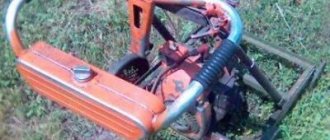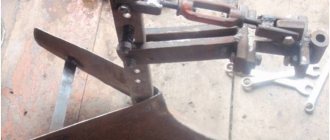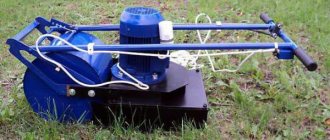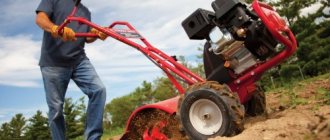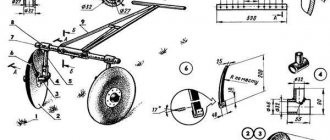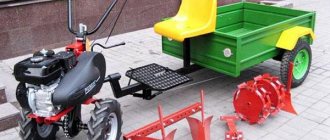Notice: Undefined variable: css_h in /home/g/grigorig/prodachnika.com/public_html/wp-content/plugins/vote2x/vote.php on line 100 Notice: Undefined variable: css_padding in /home/g/grigorig/prodachnika. com/public_html/wp-content/plugins/vote2x/vote.php on line 100 Notice: Undefined variable: css_opacity in /home/g/grigorig/prodachnika.com/public_html/wp-content/plugins/vote2x/vote.php on line 101 Notice: Undefined index: prodachnika_comvote2x9882 in /home/g/grigorig/prodachnika.com/public_html/wp-content/plugins/vote2x/vote.php on line 118 A potato hedgehog is a practical agricultural tool that simultaneously performs several important tasks. Depending on the model, this device may be a motor block hanger or a hand tool. Let's look at the purpose and functions of this tool, and also learn how to make hedgehogs for processing potatoes with your own hands: dimensions and video.
Features of hedgehogs for potatoes
Weeding potato beds with your own hands is time-consuming and energy-consuming, especially with large areas of planted territory. Therefore, the demand for specialized equipment that facilitates agricultural work is always high. Hedgehog is especially popular for potatoes.
The hedgehog is a manual or mechanical device that allows hilling and weeding of plants. That is, this tool removes all weeds from the inter-row area, loosening the soil and raking it to the beds. The plantings acquire a pleasant appearance, and the root system of the planted crop is enriched with oxygen.
Manual and mechanical devices differ little in design from each other. Only the dimensions of the mechanisms and the presence of special fasteners for the mechanical apparatus for attaching to a mini-tractor or walk-behind tractor are highlighted.
Video selection
Based on the article, weeding is carried out between the rows of root crops. Is there a weeding attachment within one row, that is, between adjacent bushes?
There is no such attachment. If only because the walk-behind tractor moves along the row spacing, and, accordingly, the movement of the nozzle also goes in the direction of the row spacing. Usually this weeding of potatoes is enough. In small areas between the bushes, they are treated with a hoe at the beginning of germination, when several leaves have appeared.
This method of weeding (hilling) potatoes is quick and convenient. But if the planting area is large. But although it is more difficult to hill up by hand, there are significantly fewer weeds.
Features of hedgehog designs
Hedgehogs are devices consisting of 3 metal rings of different sizes, welded together. Metal rods 5-10 cm long are welded to the surface of such rings. There can be 2 or more such cones made of rings. The paired structure is fastened with a special bracket, which forms an angle of 45° between the working parts of the tool. The metal frame to which such cones are attached may have a handle or a special attachment to agricultural machinery.
Another option is simplified. Instead of welded cone-shaped disks, a piece of metal pipe is installed, to which rods are welded. The resulting working part of the tool is mounted on a shaft attached to a frame with a handle.
Specifications
A cultivator is a cone-shaped device made of metal. It consists of 3 disks of different diameters, which are connected to each other by jumpers, similar to the spokes in a bicycle wheel. Pointed spikes made of a metal rod are welded to them. This device is welded into a pipe with a diameter of 25 mm, inside of which there is a non-moving axis of a smaller diameter. It is attached to the handle using a bracket.
For use as attachments, Hedgehogs can also be used in a simpler form: several pointed spikes made of a rod are attached to a piece of pipe with a diameter of 15 to 28 mm and a length of 200-250 mm using a welding machine.
You can purchase such products in agricultural supply stores, where prices are not cheap. Therefore, a large number of summer residents and gardeners prefer to make these technical devices with their own hands from scrap materials.
Benefits of hedgehogs for weeding
In addition to speeding up and facilitating agricultural activities, such a device effectively copes with the assigned tasks. Its advantages are:
- high-quality removal of weeds even before their emergence.
- loosening the soil, necessary to saturate the roots of plants with oxygen.
- possibility of additional hilling.
- correct formation of rows of seedlings.
- the ability to use the device in pest control - mice, moles, etc.
This is a rectangle and a hiller, created in one body. It has almost no flaws. The only negative is the high cost. But waste can also be avoided if you make such a machine for processing potatoes with your own hands.
Homemade hand plow
When the time comes to plant potatoes, summer residents act according to the following scheme: they make markings for planting, dig holes with a shovel, put potatoes in them and then fill them with their hands. While the potatoes are growing, they need to be hilled, most often this is done with a hoe. This takes a lot of time and effort. Today this process can be simplified as much as possible.
A hand plow is a very simple device that can be operated by 2 people at the same time. It consists of:
- 2 dump bodies for work, with a knife for trimming;
- Front pull, so that one person pulls it forward;
- Handles at the back for control by a second person.
It also performs work on cutting rows for planting, helps with hilling potatoes, and also loosens the ground.
Manual plow-hiller for planting potatoes
In order to make such a device you will need:
- Hollow pipe for a vertical stand Ø2.5 centimeters, about 1 meter long.
- A piece of hollow pipe Ø3/4 inches for making rods at the front and rear;
- A piece of sheet rod 2 millimeters thick, for making dumps;
- To connect the front rod to the vertical post, you will need a lanyard, which can be replaced with a metal plate with holes to adjust the angle of attack;
- Blowtorch or gas torch for heating metal on bends;
- Welding equipment;
- To process the joints you will need a grinder.
The long pipe must be bent at a distance of about 30 centimeters from the beginning, the angle should be 10-15°. A pipe bender will help to make bends. If it is missing, you can make a bend using the following technique:
- Fill the pipe with sand;
- We put plugs on the edges of the pipe;
We heat the intended bending area with a blowtorch and begin bending.
The smaller pipe, like the perpendicular stand, must be bent. To adjust the height, we make holes on the top edge and the same holes on the vertical section of the proposed fork.
By changing the location of the bolt in the holes, you can change the height of the stand for the comfort of the summer resident. Manual plow with traction and handles
The pull rod at the front looks the same as the one at the back, but is different in size. The height of the handle should be such that the person walking in front can easily stand between the handles, grasping them.
The height of the vertical part should be 60 centimeters, it must be made flat at the ends and holes must be drilled to connect to the vertical section.
To adjust the angle of attack, a lanyard is used, which should be located between the rod and the stand.
At a distance of 30 centimeters from below, an angle for front traction is attached to the vertical post. Then, at a distance of 25 centimeters from this hole, the same corner measuring 25x25 is welded to the fork. A hole is also made in it, and it is welded to the stand above the first corner.
2 moldboard plow
You will need 2 identical plates 2 millimeters thick. We round the bends on them. Using welding, with even seams, we attach the 2 halves of the plow to the perpendicular stand. We sand them with a grinder so that they are sharp.
Pruning knife
Knife for hilling potatoes
We take the strongest carbon steel. We cut the knife in the shape of an arrowhead and sharpen it at an angle of 45°. This angle will keep the knife sharp for a long time. Using welding, we attach it to the vertical post from below and sand it.
The manual plow is ready for work on the site!
Making a hedgehog for a walk-behind tractor
The size of the hedgehog will depend on the size of the walk-behind tractor
Features of making a mechanical hedgehog with your own hands depend on the size of the equipment, the number of cone-shaped tools and the presence of mounts for agricultural machinery. In order to make such a device, it is important to develop or purchase drawings and strictly adhere to them during the work process.
The process of constructing a cultivator itself is impossible both without a welding machine, a gas cutter for metal and other tools, and without certain skills in using them.
Materials
To make a weeder for processing potatoes, you need to prepare the required amount of materials. To make such a device you will need:
- steel sheet, 4-6 mm thick (for making working tools);
- steel strip 20-30 mm long and 4 mm thick (for jumpers);
- steel rods 8 mm thick (for spikes);
- pipe with a diameter of 25 mm (for the frame);
- steel rod, 2 cm in diameter (for the axis of the device on which the working tool will be attached);
- steel bracket, 4 mm thick, at least 7 cm wide and 20 cm long.
Adaptations
In large areas it is very difficult to handle everything manually. Here, weeding potatoes with a trimmer, walk-behind tractor or cultivator is relevant. Automation requires skill, but the process goes several times faster.
Walk-behind tractor
Many people weed potatoes with a walk-behind tractor. This is a mechanical device that cultivates the land in different ways. To work with weeds, you will need paws: they are attached to holders, adjusting the distance under the beds. Make sure that one of the paws is slightly in front - this way the plants will not get buried under them. With the help of a walk-behind tractor, it is easy to carry out not only weeding, but also hilling of potatoes. In addition to the paws, the following attachments are used in the walk-behind tractor:
- rotating cutters;
- pointed paws;
- rotating hedgehogs;
- cone urchins.
Important! Cone hedgehogs are best suited for loosening soil due to their design. There are even mini versions for especially hard-to-reach places
If desired, you can make hedgehogs for weeding potatoes yourself.
Cultivator
A device similar to a walk-behind tractor, which is cheaper and looks more compact. Cultivators are manual, gasoline and electric. The attachments for them are the same as for the walk-behind tractor, their action is similar. Most often, knives located at an angle of 45 degrees or special forks with spikes are used. Wheels make it easy to move the device. Manual versions need to be pushed in front of you; in automatic versions, the engine handles this task, you just need to control the direction. Sometimes in catalogs there is such a definition as “motor cultivator”. Most often this means a walk-behind tractor.
Trimmer
A weeding trimmer is a scythe with an electric or gasoline drive. You can get rid of weeds using special attachments. When working, you need to wear goggles that will protect your eyes, as well as rubber boots for comfort.
It is important not to lower the nozzle too far, otherwise the device may break. Once every quarter of an hour you need to take a break to give the trimmer a rest
This method of weeding requires skill, since you can accidentally touch not only weeds, but also important plants.
DIY potato weeding device
If you don’t want to spend money on equipment, but want to make manual labor easier, make the device yourself. Homemade cultivators with hedgehogs are quite effective. You will need a welding machine, a grinder, a metal cutter and materials for manufacturing:
- wide metal pipe for the base;
- frame pipe;
- metal rod and rods;
- bearings;
- corners;
- wooden handle.
First, cut a piece of pipe: this will be the axis of the future cultivator. Select parameters based on the width of the beds in the garden. Make spikes 7 centimeters long from metal rods and sharpen them at one edge at an angle of 45 degrees. Weld the resulting spikes around the circumference of the pipe, retreating 4-5 centimeters. Weld the spikes to the pipe so that they form several circles at a distance of about 4 cm from each other.
From the pipe for the frame, cut the base into a “P” shape with 35-centimeter legs to ensure unhindered rotation. Make holes on the edge of each leg. Fill the pipe with a rod or bearings, or weld the edges with pins. To assemble a homemade cultivator, insert pins or a rod into the holes of the resulting U-shaped frame. Weld the corners and attach a wooden handle. The resulting device must be pushed in front of you for weeding: the spikes will sink into the ground and weed it.
Cultivator manufacturing process
The manufacturing process of the device is carried out strictly according to the drawings. If it specifies the use of steel discs, they can be replaced with rings. Their diameter is 300, 200 and 100 mm. The process of making the tool itself goes like this:
- Using a cutter, 2 rings with an internal diameter of 20 cm and an external diameter of 30 cm are cut out (they will serve as blanks for rings with an external diameter of 20 cm).
- It is necessary to cut holes in the blanks with a diameter of 10 cm. The result of the work is 2 rings with an outer diameter of 20 cm and an inner diameter of 10 cm.
- Small disks with a diameter of 10 cm should be cut out of the remaining material (steel sheet). Holes are drilled in them for the prepared pipe with a margin, that is, 26 mm.
- Jumpers should be cut from a metal strip in the amount of 24 pieces, each 9 cm in size.
- Marks should be made on the cones where the jumpers should be welded. Large disks have 8 jumpers, and small disks have 4.
- The spikes should be cut into 12 cm pieces, and their ends should be cut off at an angle of 45° (there should be at least 80 spikes in total).
- It is necessary to weld the spikes to the disks at the required distance. There are a total of 40 spikes per cone.
- The bracket should be bent to the dimensions of the axle and welded to it.
- A frame is welded from a metal pipe and welded to the bracket.
The resulting apparatus will have two cone-shaped hedgehogs, which are located at an angle of 45° relative to each other. A properly made device should have a distance between the cones of 40-50 cm.
Marker for planting potatoes
A marker is a device that is necessary to facilitate manual activities when planting, as well as to ensure that the beds are level, with evenly distributed holes for potatoes. Subsequently, such beds are not difficult to process using mechanized or manual devices.
Today you can buy ready-made markers, but it is better to make a homemade device, then the distance between adjacent plows, for organizing holes for planting, will fully correspond to the distance between the wheels of a motor cultivator or tractor.
Markers can be basic or very complex. You can make them from any material you have at hand:
- Wooden stakes;
- Durable board;
- Special or round metal pipes.
It doesn’t matter what the device’s handle or frame is made of, the main thing is the distance between the components that make the holes
Elementary marker
This is a wooden stake approximately 90 centimeters high and about 60-70 millimeters in diameter. A horizontal rod, which is fixed at a height of about 150 millimeters from the base, will serve as a support that limits the depth of the hole. Before you start working with this device, you need to mark out future holes using twine. It is stretched along the length of the rows at a distance of approximately 40, 50, 60, 70 or 80 centimeters between the beds.
The distance between the beds depends on the subsequent method of tillage, manual or mechanized. The gap between the holes in the row is about 30 centimeters, depending on the size and variety of potatoes that will be planted.
Mittlider Marker
This is a more complex version of the marker, which is made from a pipe with an external diameter of 21 millimeters. The distance between the holes will be 29 centimeters. The cone with which the holes are made is made from a pipe Ø 55-65 millimeters. It must be welded to the frame.
Mittlider marker blueprint
On the initial row, the frame is placed parallel to the twine and, applying the necessary force, is immersed in the soil. Then we place a cone in the hole that we have marked, and continue like this. In another row, holes are made like on a chessboard. A marker made using this method allows you to plant potatoes in small areas while obtaining a high yield.
Three holes at once
This model consists of metal pipes and 3 cones.
Marker drawing for planting potatoes in 3 holes
The welded frame of the marker is made from a special light and strong pipe measuring 25x25x2 millimeters. To do this, you can take an ordinary steel pipe Ø 32 millimeters, which is used for water supply or gas pipelines. Cones are made of aluminum or acacia wood, oak.
A hole is made in the cylindrical part and an M8 thread is cut. Three such through holes Ø 9 millimeters are made in the pipe. Through these holes the cones are attached to the frame with M8 bolts. Using bolts measuring 40-80 millimeters, you can adjust the depth of the hole. The distance between the cones is 45 centimeters. To avoid injury, plugs must be placed on the open ends of the supporting pipe. The height of the bolts may vary. This will depend on the depth of the hole required. The larger the bolt, the wider the possibilities.
Marker for planting potatoes in 3 holes
Wooden cones must be sanded, varnished or drying oil applied so that soil does not stick to them when working. All metal components must be treated against corrosion. The height of the frame must be adjusted to your height. The values indicated in the drawing are suitable for a summer resident with a height of 175 centimeters.
Hedgehogs for walk-behind tractors
Walk-behind tractors with special replaceable attachments are often used for gardening and field work. With their help, you can loosen the soil, prepare the land for planting, remove weeds and harvest.
Hedgehogs on a walk-behind tractor are specialized devices with which you can process beds of potatoes in one pass, loosen the soil and hill up the seedlings.
This type of equipment is suitable for:
- clearing the area of weeds;
- loosening the soil;
- formation of rows;
- hilling without damaging potato roots;
- repelling pests.
What are they?
Despite the fact that the main function of all hedgehogs is the same, there are several types of such tools, with slightly different designs.
Differences affect the effectiveness of a hedgehog in an area of one size or another.
For processing potatoes in one furrow
Single-furrow potato hedgehogs are designed for weeding small areas. The simplified design of this type of hedgehog makes the work of the gardener easier, representing a pipe 250 mm long, on which several disks with metal spikes 150-200 mm long are fixed.
Fastening is carried out by 2 bearings and a shaft. This design is usually attached to a walk-behind tractor to simplify the work and save time when weeding potatoes.
For weeding potatoes on bearings
Hedgehogs on bearings are designed for weeding beds ranging in size from 60 to 90 cm. They are used immediately after emergence and after ground tillage.
The advantage of this type of hedgehogs is that they have a bearing unit, which provides additional fixation, as well as 3-position adjustment of the weeding angle, which ensures high-quality loosening of the earth.
Rotary weeding
The purpose of rotary hedgehogs is pre- and post-emergence soil treatment. These hedgehogs simultaneously fluff up and hill up the soil, while removing weeds. In this case, the row spacing varies between 50-75 cm.
Processing potatoes with rotary hedgehogs is not a labor-intensive process, since the rippers can be attached to any walk-behind tractor, cultivator, and even mini-tractor.
Design and features of hedgehogs
Hedgehogs for processing potatoes are one of the best helpers for a gardener.
Unlike flat cutters, such devices remove weeds with roots, loosen the soil, allowing it to pass moisture and oxygen to the potatoes, and repel pests. This allows you to get a rich harvest, hilling without damaging potato roots or repelling pests. The equipment is a special metal device of a conical or other shape, which consists of three rings of different sizes. They are connected with special jumpers, and metal spikes are also welded to them.
This design of hedgehogs provides:
- effective removal of all weeds;
- quick and easy fluffing of the soil;
- simple garden or field care.
Based on their functionality, models can be divided into two types:
- Rotary - using this technique you can weed, fluff up the soil, and hill up rows.
- Conical - used to remove weeds even before the first potato shoots appear.
Why are hedgehogs needed to process potatoes?
The main purpose of hedgehogs for processing potatoes is to form a well-developed root system so that it produces more root crops. During weeding and hilling, the soil is saturated with oxygen and stores water much better. The process should not be carried out very often, otherwise you may end up injuring the roots and upper parts of the plant. Agronomists recommend weeding and hilling once every 3 weeks. Thanks to their special design, hedgehogs for processing potatoes can simultaneously perform a number of operations, for example:
- clear the area of weeds, not by cutting them, but by removing them by the roots, which guarantees the destruction of the weed;
- loosen and fluff the soil, thereby ensuring access of rainwater and oxygen to the tubers;
- create a convenient row structure, which helps during harvesting;
These devices can be used on any type of soil and in fields of different sizes. They will help create a site that you can be proud of. Hedgehogs are sold together with a walk-behind tractor; often when purchasing a walk-behind tractor they are included in the kit by default. If they were not included in the kit, then it’s okay, they can be additionally ordered in specialized stores.
Do-it-yourself hedgehogs for weeding potatoes with a walk-behind tractor
Additional equipment for the units is available for free sale. But you can make such devices with your own hands, devoting a little time and skill to this.
To make hedgehogs, you can use our drawings, which show the correct location of all the parts.
Step-by-step instructions for making hedgehogs for walk-behind tractors with your own hands:
- You need to prepare three metal disks or rings, the sizes of which must be different. For example, these could be the following proportions: 100 mm, 200 mm and 300 mm.
- The discs are assembled on a pipe of a suitable diameter, starting with the largest, so that it then ends up inside the structure. A distance of 18 cm or less is left between them.
- Spikes are welded to the disks, the length of which should be 10-14 cm. The smallest wheel should have 5 studs, the medium one should have 10, and the largest one should have 15. Several studs should also be fixed on the axle.
- The hedgehogs are attached to the walk-behind tractor using bushings and jumpers. In this case, you must maintain an angle of 45 degrees.
- Next, two guide wheels are installed on the structure itself, which reduce the load on the attached structure.
Hedgehogs are indispensable devices for processing potatoes with a walk-behind tractor. They help to significantly save time and effort, completely get rid of weeds and get a rich harvest. Due to its versatility, the equipment is suitable for units from different manufacturers, including Neva, Agat, Oka and others, it is as simple and straightforward to use as possible and is highly efficient.
Adaptations
In large areas it is very difficult to handle everything manually. Here, weeding potatoes with a trimmer, walk-behind tractor or cultivator is relevant. Automation requires skill, but the process goes several times faster.
Walk-behind tractor
Many people weed potatoes with a walk-behind tractor. This is a mechanical device that cultivates the land in different ways. To work with weeds, you will need paws: they are attached to holders, adjusting the distance under the beds. Make sure that one of the paws is slightly in front - this way the plants will not get buried under them. With the help of a walk-behind tractor, it is easy to carry out not only weeding, but also hilling of potatoes. In addition to the paws, the following attachments are used in the walk-behind tractor:
- rotating cutters;
- pointed paws;
- rotating hedgehogs;
- cone urchins.
Important! Cone hedgehogs are best suited for loosening soil due to their design. There are even mini versions for especially hard-to-reach places. If desired, you can make hedgehogs for weeding potatoes yourself
If desired, you can make hedgehogs for weeding potatoes yourself.
Cultivator
A device similar to a walk-behind tractor, which is cheaper and looks more compact. Cultivators are manual, gasoline and electric. The attachments for them are the same as for the walk-behind tractor, their action is similar. Most often, knives located at an angle of 45 degrees or special forks with spikes are used. Wheels make it easy to move the device. Manual versions need to be pushed in front of you; in automatic versions, the engine handles this task, you just need to control the direction. Sometimes in catalogs there is such a definition as “motor cultivator”. Most often this means a walk-behind tractor.
Trimmer
A weeding trimmer is a scythe with an electric or gasoline drive. You can get rid of weeds using special attachments. When working, you need to wear goggles that will protect your eyes, as well as rubber boots for comfort.
It is important not to lower the nozzle too far, otherwise the device may break. Once every quarter of an hour you need to take a break to give the trimmer a rest. This method of weeding requires skill, since you can accidentally touch not only weeds, but also important plants
This method of weeding requires skill, since you can accidentally touch not only weeds, but also important plants.
DIY potato weeding device
If you don’t want to spend money on equipment, but want to make manual labor easier, make the device yourself. Homemade cultivators with hedgehogs are quite effective. You will need a welding machine, a grinder, a metal cutter and materials for manufacturing:
- wide metal pipe for the base;
- frame pipe;
- metal rod and rods;
- bearings;
- corners;
- wooden handle.
First, cut a piece of pipe: this will be the axis of the future cultivator. Select parameters based on the width of the beds in the garden. Make spikes 7 centimeters long from metal rods and sharpen them at one edge at an angle of 45 degrees. Weld the resulting spikes around the circumference of the pipe, retreating 4-5 centimeters. Weld the spikes to the pipe so that they form several circles at a distance of about 4 cm from each other.
From the pipe for the frame, cut the base into a “P” shape with 35-centimeter legs to ensure unhindered rotation. Make holes on the edge of each leg. Fill the pipe with a rod or bearings, or weld the edges with pins. To assemble a homemade cultivator, insert pins or a rod into the holes of the resulting U-shaped frame. Weld the corners and attach a wooden handle. The resulting device must be pushed in front of you for weeding: the spikes will sink into the ground and weed it.
What are the advantages of using hedgehogs for weeding?
The advantages of using hedgehogs on a walk-behind tractor are obvious to every farmer.
They allow:
- perform effective weeding of an area planted with potatoes - during operation, they do not cut off the stems of weeds, but wind them together with the roots, which allows you to achieve the best results when processing the beds;
- loosen and hill up the soil, which will increase the amount of moisture, oxygen and heat received by plants;
- get rid of pests - hedgehogs on a walk-behind tractor effectively repel the ubiquitous rodents and turn out harmful insects, which feel comfortable and actively reproduce only with a layer of soil;
- help to level the soil layer on a planted bed and cultivate the bed.
By using hedgehogs on a walk-behind tractor, the owner of the plot has the opportunity to save his time and effort, which is very important when growing large quantities of potatoes on large plots.
How to quickly weed potatoes
In any case, weeding potatoes will require some effort and time. At the same time, there are methods that allow you to do this faster, while weeding with a regular hoe is the slowest way.
First of all, it is important to remember that it is better to water the soil 2-3 days before weeding, since it will be harder to weed into dry soil. At the same time, you should not flood the area so much that dirt remains on it for several days - this will not only delay weeding, but can also negatively affect the health of the plants
Among hand tools, faster weeding will be ensured by flat cutters of the “Swift” and “Gardener” types, which can additionally be equipped with star-shaped wheels to facilitate movement. Weeding is done with forward movements away from you, deepening the blade of the tool by 2-3 cm.
As for mechanical tools, quick weeding will be provided by a trimmer or walk-behind tractor. As mentioned above, a trimmer can only weed, but not hill up the beds. At the same time, you can install a V-shaped attachment on the walk-behind tractor, which will ensure cutting high-quality ridges in potato beds.
Do-it-yourself hedgehogs for weeding potatoes with a walk-behind tractor
Hedgehogs for a walk-behind tractor have another significant advantage, namely, a simple design, making them extremely easy to make with your own hands. All that is required for this is the availability of the necessary equipment and materials, as well as the study of detailed diagrams. The drawings will help you assemble the equipment sequentially without making mistakes. It is extremely important that the dimensions of all parts are indicated in the diagram, otherwise the ripper will turn out to be disproportionate, and during operation it will always drift in a certain direction.
Reviews from experienced gardeners
Gardeners who used hedgehogs to weed potatoes share their impressions.
Vitaly Panasenkov, Krasnodar: “I recommend buying hedgehogs for a walk-behind tractor in a special store. Otherwise, you will have to draw up a really competent drawing of a hedgehog, otherwise the effectiveness of weeding will be minimal.”
Anton Krasnov, Izhevsk: “Don’t forget to paint the hedgehogs. This will save the wheels from rust much better than any anti-corrosion agent.”
This is interesting:
What does the trimmer attachment for weeding potatoes look like and how to use it correctly
Detailed descriptions and effective methods for treating potato diseases
Reasons for tops drying out and whether potatoes grow after this
